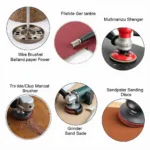Car bodywork repair sanding primer is a crucial step in achieving a flawless finish. A properly applied and sanded primer creates a smooth, uniform surface for the paint to adhere to, ensuring a professional and long-lasting repair. This article delves into the nuances of sanding primer, providing a comprehensive guide for both DIY enthusiasts and professionals. We’ll cover everything from choosing the right primer to achieving a perfect sanded surface, ready for paint. After reading this, you’ll be equipped to tackle your car bodywork repairs with confidence.
Choosing the Right Car Bodywork Repair Sanding Primer
Selecting the correct primer is the foundation of a successful repair. There are various types of primers available, each designed for specific purposes and materials. For instance, epoxy primers offer excellent adhesion and corrosion protection, making them ideal for bare metal surfaces. Meanwhile, urethane primers are known for their fast drying times and smooth finish, perfect for filling minor imperfections. Knowing the properties of each primer type allows you to choose the one best suited for your particular repair. Consider the type of damage, the material of the car body, and the environmental conditions when making your selection. For smaller repairs, a car body repair kit uk might be all you need.
Preparing the Surface for Primer Application
Before applying primer, proper surface preparation is essential. This involves thoroughly cleaning the area to be repaired, removing any rust, grease, or old paint. A clean surface ensures optimal primer adhesion and prevents future issues like peeling or bubbling. Use a degreaser and a sanding block to remove any contaminants and create a slightly rough surface for the primer to grip. This step, although often overlooked, is crucial for a professional and long-lasting repair.
Why is surface preparation important?
Surface preparation is crucial for optimal primer adhesion and a long-lasting repair, preventing issues like peeling or bubbling.
Applying the Car Bodywork Repair Sanding Primer
Apply the primer in thin, even coats, allowing each coat to dry completely before applying the next. This prevents runs and sags, ensuring a smooth and uniform surface. Multiple thin coats are always preferable to one thick coat, as they provide better coverage and adhesion. Remember to follow the manufacturer’s instructions for drying times and application techniques. If you’re dealing with a specific color issue, understanding car body repair reddish can be helpful.
How many coats of primer should I apply?
Apply multiple thin coats of primer, allowing each to dry completely, rather than one thick coat, for optimal coverage and adhesion.
Sanding the Primer: Achieving a Flawless Finish
Once the primer is completely dry, the sanding process begins. Start with a coarser grit sandpaper (e.g., 320-grit) to remove any imperfections and level the surface. Gradually move to finer grits (e.g., 400-grit, then 600-grit) to achieve a smooth, glass-like finish. Use a sanding block to ensure even pressure and prevent dips or scratches. Proper sanding technique is critical for a professional-looking paint job. You might find tools like those available for car body repair tools australia useful for this task.
Common Mistakes to Avoid
- Sanding too aggressively: This can remove the primer entirely, exposing the bare metal and requiring you to start over.
- Using the wrong grit sandpaper: Using too coarse a grit can scratch the primer, while too fine a grit may not level the surface effectively.
- Not allowing the primer to dry completely: Sanding before the primer is dry can clog the sandpaper and create an uneven surface.
“Proper surface preparation and sanding technique are fundamental for a high-quality paint job,” says John Smith, Automotive Refinishing Specialist. “Take your time and focus on each step to achieve professional results.”
What grit sandpaper should I use for sanding primer?
Start with coarser grit sandpaper (e.g., 320-grit) and gradually move to finer grits (e.g., 400-grit, then 600-grit) for a smooth finish.
Conclusion
Mastering car bodywork repair sanding primer is essential for achieving a flawless, professional-looking paint job. By following the steps outlined in this article, you can ensure a smooth, uniform surface that’s ready for paint. Remember to choose the correct primer, prepare the surface thoroughly, and sand with the appropriate grits. If you’re looking for repair services in specific areas, you can explore options for car body repair in blandford forum or car body repair cookstown. With careful attention to detail and proper technique, you can achieve outstanding results in your car bodywork repairs.
FAQ
- What is the purpose of car bodywork repair sanding primer?
- What are the different types of primers available?
- How do I prepare the surface for primer application?
- What grit sandpaper should I use for sanding primer?
- What are some common mistakes to avoid when sanding primer?
- How can I achieve a smooth, glass-like finish when sanding primer?
- What should I do if I sand through the primer?
Need further assistance with your car repair needs? Contact us via WhatsApp: +1(641)206-8880 or Email: [email protected]. Our 24/7 customer support team is always ready to help.

